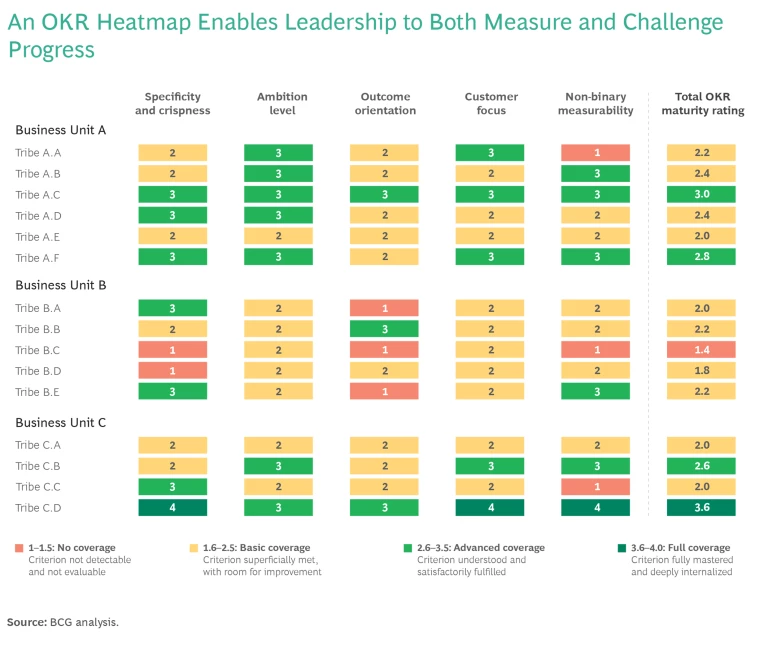In today’s dynamic and hyper-competitive business landscape, organizations seek fresh ways to focus, align, and rapidly progress toward successful strategic deployment. Objectives and Key Results (OKR), an increasingly popular methodology, has emerged as a go-to framework to significantly improve performance.
The concept of OKRs is simple and compelling. It’s about setting a clear objective, formulating measurable action steps and milestones (referred to as “key results”), and eliminating obstacles in the organizational landscape. But the journey from theory to effective practice can be difficult.
In today’s dynamic and hyper-competitive business landscape, organizations seek fresh strategic deployments.
Indeed, many companies struggle to implement a consistently mature level of OKRs. All too often, OKRs suffer from low overall quality in both design and execution, and take far too long to reach a meaningful stage of evolution—or, they never move past the status of being just another goal-setting framework for isolated teams and projects.
Take, for example, this initial version of an OKR designed for an IT department:
Objective: We will roll out our new data platform.
Key Results:
- Tell 65% of our customers about our great innovation capabilities.
- Existing customers are happy with our new services.
- Perform a pilot for the new data solution.
This unfortunate OKR lacks clarity, customer focus, measurability, and ambition. It creates the illusion that rolling out a data platform is the objective, when the true goal is to achieve deeper customer satisfaction and higher business value. The data platform itself is only a means to an end, whereas an effective OKR should reflect the end rather than the means.
After internal discussion and BCG interaction with company leadership, the OKR was improved to:
Objective: Customers will experience our new data offerings as both innovative and strongly value-enhancing.
Key Results:
- Achieve a level of 65% of clients perceiving our innovation capabilities as better than those of our competitors, as measured by an ongoing survey.
- Reach average customer ratings of four out of five stars in service experience, as surveyed after every service request.
- Pilot implementations of new data offerings to achieve a 40% cost reduction compared to previous implementations.
A key initial step in implementing OKRs is to ensure a holistic approach and a high level of maturity.
This improved OKR offers a specific goal to be achieved within a year, clear measurability and ambition, and the targeted customer impact. It enables the IT department head to provide the company’s executive board with a roadmap to tangible business outcomes. This in turn allows the board to make an informed decision and sign off on the IT department’s plan.
In our experience, a key initial step in implementing successful OKRs and harnessing their power to drive transformational outcomes—particularly in change-focused business units—is to ensure a holistic approach and a high level of maturity from the outset. Yet, to do this, there are common challenges to overcome.
The Challenges of OKR Implementation
Although awareness of OKRs has been high for a number of years, their full potential often remains untapped for a variety of reasons. Among these are a lack of standardization, misalignment among different stakeholders, and overall insufficient management understanding of how to structure and execute a winning OKR. The effort is there on the part of many organizations, but the experience and savoir faire is not—at least not yet. Organizations frequently encounter the following five issues.
1. A lack of standardization and understanding. The effectiveness of OKRs hinges on their methodological maturity—the extent to which the objectives and key results show easy measurability and high overall clarity. Yet many organizations struggle to establish a standard for OKRs, resulting in fragmented implementation across different teams and departments, or even worse, the repositioning of old, inconsistent, process-focused goals as OKRs. This lack of standardization often leads to confusion, hindering the ability to communicate and align on targeted business outcomes, to assess OKR quality and maturity accurately, and to achieve goals in a way that truly captures customer value.
2. Isolated implementation. When not seamlessly integrated with performance targets such as KPIs (Key Performance Indicators) and activities (such as TIES, an agile-based concept involving Themes, Initiatives, Epics, and Stories), OKRs can lead to overlaps in steering and governance. Parts of the organization can carry out duplicated work without realizing it. OKRs can truly streamline value creation only when fully integrated within the overall steering process. In this way, they can serve as stepping stones toward ambitious KPI goals and provide foundations for strategic activities.
3. Ineffective monitoring and measuring. Many companies do not know how to monitor and measure OKRs accurately, which leaves leaders less able to challenge managers on progress. This in turn can result in subpar impact and missed revenue opportunities. Without a clear assessment method, the outcomes of OKR efforts become difficult to gauge, limiting their potential to create business value. Most corporate leaders, at least those without extensive experience in working with OKRs, do not yet possess the background or tools to challenge OKRs quickly and comprehensively.
4. Excessive and unproductive training time. Traditional approaches to OKR training and formulation can consume large chunks of time and resources. They also often focus on the wrong areas. Without using standardized OKR methodology and design, coaches can spend hours explaining how to create a good OKR without having a quantifiable evaluation process that OKR owners can be measured against. The complexity associated with such training can transform OKRs into a mystifying concept rather than a practical tool for driving progress. Such complexity can also prompt leaders to create “textbook” OKRs without understanding the real power behind them.
5. Lack of commitment and accountability. OKRs show their full impact only when managers take full responsibility for navigating budget and capacity constraints and for driving their objective’s overall level of success. Nonetheless, many companies do not hold their managers fully accountable for their commitments, nor examine in detail what might have gone wrong with a failed effort, or work with the manager to achieve a better result the next time around. At the same time, managers must be enabled and empowered to target moonshot goals. The overall process is not necessarily about achieving 100% of key results, but about accountability for setting ambitious outcomes, committing to them, and delivering to the highest extent feasible under current circumstances.
The multiple challenges listed above are indeed daunting, and many organizations have yet to detect that most of their assumptions about OKRs are not fully on the mark. In our experience, standardizing and scaling the methodology—as well as continuously assessing OKR maturity and focusing on the most important goals for business impact—will go a long way toward achieving the targeted OKR outcomes. But companies need a clear path to follow.
A Path to OKR Maturity and Impact
To address the challenges of OKRs, organizations need a pragmatic approach that shifts the focus from method to true mindset, from indecision to impact. Companies should empower HR and agile coaches to facilitate this transformation. In our view, and in the experience of our clients, corporate leaders can unleash the true power of OKRs with a battle-tested scaling approach consisting of five imperatives.
1. Simplify methodological standards and demystify OKRs across the organization.
Companies should employ an OKR checklist of distinct criteria, such as the one outlined below, to be assessed at the outset.
- Specificity and crispness: Is the OKR written in a clear, concise, and compelling way? (It should not be longer than a few lines or require multiple reads).
- Ambition level: Does the OKR describe an aspiring, yet achievable (with high effort) future state, a true moon shot? (The OKR should not reflect business as usual or a routine, easily achievable goal).
- Outcome orientation: Does the OKR describe an unambiguous added value for the customer and/or stakeholder? (It should describe future target states in a concise manner).
- Customer focus: Does the OKR clearly identify the customer and/or stakeholder and provide razor-sharp focus on these parties? (The OKR should specify exactly who will benefit from the endeavor).
- Non-binary measurability: Are the key results continuously measurable, and do they foster rapid and effective decision-making? (Key results should not be just binary—meaning achievable either fully or not at all—and should be measured on an ongoing basis to gauge progress).
Unleash the true power of OKRs with a battle-tested scaling approach consisting of five imperatives.
Such a checklist demystifies and standardizes OKRs for the entire organization. Acting on these criteria further empowers leaders to challenge their teams’ OKRs quickly and effectively during quarterly and annual business reviews.
2. Make OKRs easily and transparently assessable. Companies need to implement an OKR heatmap, based on the criteria outlined in the above checklist, to measure the progress of different units within an organization and to challenge OKR maturity. (See the Exhibit). Although transparency in maturity levels initially can be uncomfortable for some leaders, it provides vital guidance for deploying scarce coaching and training resources effectively and can help foster productive internal competition for OKR progress. Transparency also permits the board to effectively challenge managers’ outcome commitments against each other, and to make informed strategic and budget decisions.

3. Deploy OKRs to your change-oriented businesses. Use OKRs only in areas where they can create true impact. Do not use them to steer your daily businesses and operations but employ them for change-focused units only. Given the resources needed to successfully implement OKRs, the ROI is far higher in areas of high complexity and high change potential.
4. Leverage GenAI to save time and to shift discussions toward outcomes for customers.
Companies should utilize tools such as
GenAI
to help formulate OKRs across the organization. Such an approach can significantly reduce the time spent on OKR methodology training and development, allowing leaders to concentrate on fostering an OKR mindset.
While AI technology cannot replace the human resources and expertise required for successful OKR implementation, it can provide highly useful assistance in achieving speed and efficiency when designing OKRs. Our case experience has demonstrated that GenAI can significantly accelerate the process of formulating and assessing OKRs.
5. Establish quarterly and annual business reviews to oversee OKRs.
Funding and capacity decisions in the steering model of an organization should be fully connected to OKRs. BCG has developed an agile steering system that includes quarterly and annual business reviews, as well as so-called big room plannings—frameworks that permit organizations to review, discuss, align on, and commit to OKRs on all levels of the company. The deep integration of OKRs into the steering system allows for holistic management of targets, activities, resources, and funding. Leaders need a 360-degree view on their strategy execution, with OKRs as a core steering artifact. Our case experience shows that deep OKR integration in governance and strategy-execution processes can become a powerful force in driving an outcome-oriented mindset and creating both client impact and business value across the entire organization.
Real Evidence, Real Impact
The transformational potential of OKRs is not just theoretical but is supported by real evidence. Our experience with Enterprise Agility clients vividly reveals the challenges organizations face with OKR implementation, as well as how to overcome them.
Indeed, we have witnessed remarkable shifts in organizational cultures that have simplified and standardized OKR practices. Leaders who previously struggled to comprehend OKRs quickly adopted the checklist and heatmap approach, enabling them to assess and challenge OKRs. This shift in focus has facilitated a transition to entrepreneurial, minimum-viable-product strategies that prioritize customer impact.
The transformational potential of OKRs is not just theoretical but is supported by real evidence.
One revealing illustration is provided by Bosch Digital, the digital unit of Robert Bosch GmbH, the multinational engineering and technology company. By choosing the above approach, Bosch Digital was able to improve and scale the maturity of its OKRs within a very short time frame. BCG helped the company standardize and radically simplify its OKR landscape by defining simple, clear, quality criteria and by introducing a consistent and transparent OKR maturity rating. This approach was integrated within a holistic quarterly and annual business review system, which also utilized KPIs and TIES.
Before and during the business reviews, BCG conducted OKR maturity checks and reported back to company leaders via transparent heatmaps. This phase was followed by targeted sparring and coaching with the leaders on OKRs—interactions that revealed room for further improvement. BCG provided clear insight into the maturity of the OKRs and established a benchmark for consistency and quality. The heatmap gamified the OKR definition process and encouraged different business units to strive for better OKR formulation.
BCG’s overall approach also mitigated the risk of scaling poorly-defined OKRs, which could have led to a high number of ineffective efforts, thus damaging confidence in the methodology. The cycle of regular checks and adjustments was pivotal, not only in enhancing OKR quality swiftly but in managing coaching resources effectively by directing them toward units that needed specific improvements. The net result was a significant upsurge in OKR quality within two weeks. This result supported an outcome- and customer-oriented ethos, thereby fostering an agile mindset across the leadership of Bosch Digital and enabling the company to create highly mature OKRs on a team level.
Ultimately, the journey toward harnessing the power of OKRs requires leaders to unify, demystify, and scale the OKR framework across their organizations. By implementing crystal-clear methodological standards, utilizing hands-on tools, leveraging GenAI, making OKR maturation transparent, and fostering an outcome oriented OKR mindset, leaders can transcend the challenges and realize the full potential of OKRs. In so doing, they will accelerate time-to-market and improve true customer and business value.












